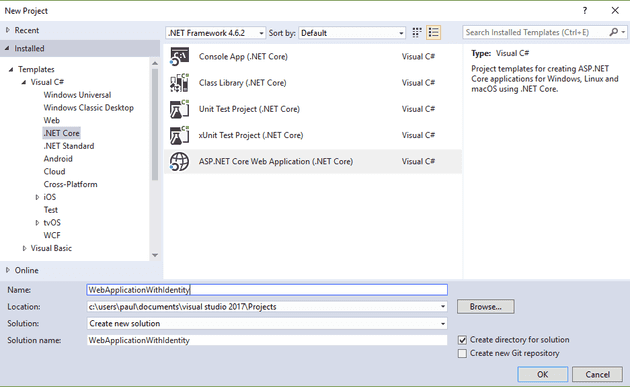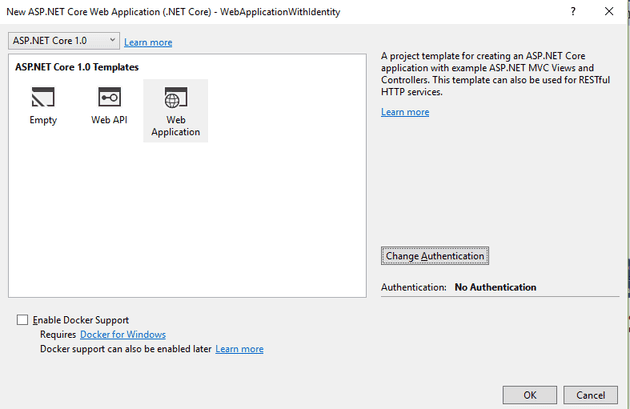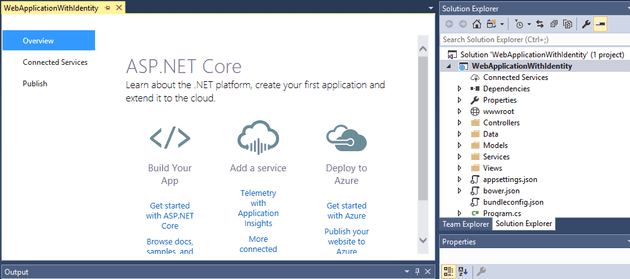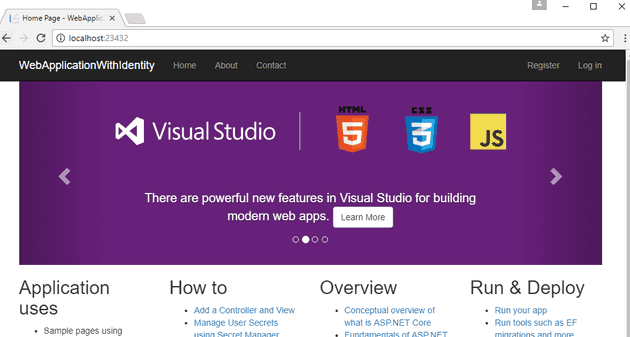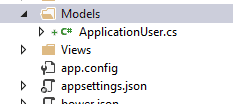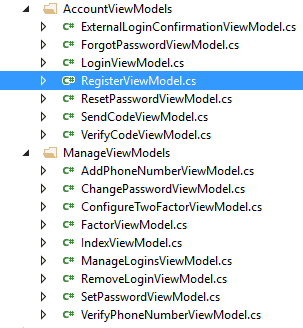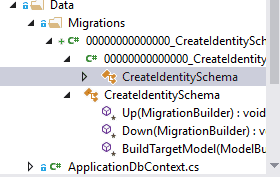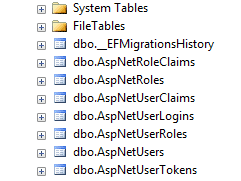If you create a new ASP.Net application, you get a built-in log-in feature - it provides the log-in page, all the back end services and even the DB tables. It does assume that your DB and your web-site are physically located on the same server (or at least that the web site can directly access the DB). Asp.Net Core also provides this, but it’s slightly different. It does still use Entity Framework (Core), and it does still assume direct access to the DB.
For a new application
Adding this functionality to a new application is very straightforward…
Step One - Create a new Asp.Net Core Web App
Step Two - Add authentication
Select “Change Authentication”:
If you’re creating a standard self-authenticating web page, then Individual is the answer. “Windows Authentication” allows you to defer authentication to your domain, and “Work or School Account” allows you to use Microsoft’s own security using AD, Azure or Office 365.
Step Three - Log-in
Now, just log-in:
So far so good; but what if you have already created a web app using ASP.Net Core and want to retrospectively fit this functionality?
For Existing Applications
Obviously, adding this functionality can depend on what you’re adding it to. The following was compiled from an ASP.Net Core app created without identity services, and then retrofitted with them. In order to do this, I strongly recommend starting with a dummy app created as above, as there’s a lot of cutting and pasting coming up.
Step One - Add Entity Framework
The identity service is built on top of EF (Core in this case); so add:
Microsoft.AspNetCore.Identity.EntityFrameworkCore
Step Two - The ApplicationUser Model
You need to add the concept of IdentityUser to your application to use the ASP.Net Core Identity functionality; so you will need a model to represent your user:
This should inherit from IdentityUser:
using Microsoft.AspNetCore.Identity.EntityFrameworkCore;
using System;
using System.Collections.Generic;
using System.Linq;
using System.Threading.Tasks;
namespace MyWebApp.Models
{
public class ApplicationUser : IdentityUser
{
}
}
Step Three - ApplicationDbContext
You need a DBContext; this provides an abstraction for EF and allows it to work out how to create your DB, etc.; create a Data folder:
And add a class similar to the following:
using MyWebApp.Models;
using Microsoft.AspNetCore.Identity.EntityFrameworkCore;
using Microsoft.EntityFrameworkCore;
using System;
using System.Collections.Generic;
using System.Linq;
using System.Threading.Tasks;
namespace MyWebApp.Data
{
public class ApplicationDbContext : IdentityDbContext<ApplicationUser>
{
public ApplicationDbContext(DbContextOptions<ApplicationDbContext> options)
: base(options)
{
}
protected override void OnModelCreating(ModelBuilder builder)
{
base.OnModelCreating(builder);
// Customize the ASP.NET Identity model and override the defaults if needed.
// For example, you can rename the ASP.NET Identity table names and more.
// Add your customizations after calling base.OnModelCreating(builder);
}
}
}
Step Four - Startup.cs
With ASP.Net Core there is an opt-in policy; so all the functionality that you might need is registered in an IoC first (including MVC). The identity service needs to be registered in Startup.ConfigureServices:
// This method gets called by the runtime. Use this method to add services to the container.
public void ConfigureServices(IServiceCollection services)
{
services.AddIdentity<ApplicationUser, IdentityRole>()
.AddEntityFrameworkStores<ApplicationDbContext>()
.AddDefaultTokenProviders();
// Add framework services.
services.AddMvc();
}
Step Five - Services
To deal with two factor authentication, you’ll need an implementation of a message sender. I initially became confused with this naming, and it refers to a class that sends messages (e-mails, etc), and not message in any of the many other senses you may imagine.
public interface IEmailSender
{
Task SendEmailAsync(string email, string subject, string message);
}
public interface ISmsSender
{
Task SendSmsAsync(string number, string message);
}
public class AuthMessageSender : IEmailSender, ISmsSender
{
public Task SendEmailAsync(string email, string subject, string message)
{
// Plug in your email service here to send an email.
return Task.FromResult(0);
}
public Task SendSmsAsync(string number, string message)
{
// Plug in your SMS service here to send a text message.
return Task.FromResult(0);
}
}
Step Six - ViewModels and Views
I won’t detail them all here, but you’ll need view models and views to cover all the basic functionality (register, reset, login, etc…):
Step Seven - AccountController
The controllers are the drivers for functionality in MVC; the following details how the log-in system will function.
[code lang=“csharp” collapse=“true”]
[Authorize]
public class AccountController : Controller
{
private readonly UserManager
public AccountController(
UserManager<ApplicationUser> userManager,
SignInManager<ApplicationUser> signInManager,
IOptions<IdentityCookieOptions> identityCookieOptions,
IEmailSender emailSender,
ISmsSender smsSender,
ILoggerFactory loggerFactory)
{
\_userManager = userManager;
\_signInManager = signInManager;
\_externalCookieScheme = identityCookieOptions.Value.ExternalCookieAuthenticationScheme;
\_emailSender = emailSender;
\_smsSender = smsSender;
\_logger = loggerFactory.CreateLogger<AccountController>();
}
//
// GET: /Account/Login
[HttpGet]
[AllowAnonymous]
public async Task<IActionResult> Login(string returnUrl = null)
{
// Clear the existing external cookie to ensure a clean login process
await HttpContext.Authentication.SignOutAsync(\_externalCookieScheme);
ViewData["ReturnUrl"] = returnUrl;
return View();
}
//
// POST: /Account/Login
[HttpPost]
[AllowAnonymous]
[ValidateAntiForgeryToken]
public async Task<IActionResult> Login(LoginViewModel model, string returnUrl = null)
{
ViewData["ReturnUrl"] = returnUrl;
if (ModelState.IsValid)
{
// This doesn't count login failures towards account lockout
// To enable password failures to trigger account lockout, set lockoutOnFailure: true
var result = await \_signInManager.PasswordSignInAsync(model.Email, model.Password, model.RememberMe, lockoutOnFailure: false);
if (result.Succeeded)
{
\_logger.LogInformation(1, "User logged in.");
return RedirectToLocal(returnUrl);
}
if (result.RequiresTwoFactor)
{
return RedirectToAction(nameof(SendCode), new { ReturnUrl = returnUrl, RememberMe = model.RememberMe });
}
if (result.IsLockedOut)
{
\_logger.LogWarning(2, "User account locked out.");
return View("Lockout");
}
else
{
ModelState.AddModelError(string.Empty, "Invalid login attempt.");
return View(model);
}
}
// If we got this far, something failed, redisplay form
return View(model);
}
//
// GET: /Account/Register
[HttpGet]
[AllowAnonymous]
public IActionResult Register(string returnUrl = null)
{
ViewData["ReturnUrl"] = returnUrl;
return View();
}
//
// POST: /Account/Register
[HttpPost]
[AllowAnonymous]
[ValidateAntiForgeryToken]
public async Task<IActionResult> Register(RegisterViewModel model, string returnUrl = null)
{
ViewData["ReturnUrl"] = returnUrl;
if (ModelState.IsValid)
{
var user = new ApplicationUser { UserName = model.Email, Email = model.Email };
var result = await \_userManager.CreateAsync(user, model.Password);
if (result.Succeeded)
{
// For more information on how to enable account confirmation and password reset please visit https://go.microsoft.com/fwlink/?LinkID=532713
// Send an email with this link
//var code = await \_userManager.GenerateEmailConfirmationTokenAsync(user);
//var callbackUrl = Url.Action(nameof(ConfirmEmail), "Account", new { userId = user.Id, code = code }, protocol: HttpContext.Request.Scheme);
//await \_emailSender.SendEmailAsync(model.Email, "Confirm your account",
// $"Please confirm your account by clicking this link: <a href='{callbackUrl}'>link</a>");
await \_signInManager.SignInAsync(user, isPersistent: false);
\_logger.LogInformation(3, "User created a new account with password.");
return RedirectToLocal(returnUrl);
}
AddErrors(result);
}
// If we got this far, something failed, redisplay form
return View(model);
}
//
// POST: /Account/Logout
[HttpPost]
[ValidateAntiForgeryToken]
public async Task<IActionResult> Logout()
{
await \_signInManager.SignOutAsync();
\_logger.LogInformation(4, "User logged out.");
return RedirectToAction(nameof(HomeController.Index), "Home");
}
//
// POST: /Account/ExternalLogin
[HttpPost]
[AllowAnonymous]
[ValidateAntiForgeryToken]
public IActionResult ExternalLogin(string provider, string returnUrl = null)
{
// Request a redirect to the external login provider.
var redirectUrl = Url.Action(nameof(ExternalLoginCallback), "Account", new { ReturnUrl = returnUrl });
var properties = \_signInManager.ConfigureExternalAuthenticationProperties(provider, redirectUrl);
return Challenge(properties, provider);
}
//
// GET: /Account/ExternalLoginCallback
[HttpGet]
[AllowAnonymous]
public async Task<IActionResult> ExternalLoginCallback(string returnUrl = null, string remoteError = null)
{
if (remoteError != null)
{
ModelState.AddModelError(string.Empty, $"Error from external provider: {remoteError}");
return View(nameof(Login));
}
var info = await \_signInManager.GetExternalLoginInfoAsync();
if (info == null)
{
return RedirectToAction(nameof(Login));
}
// Sign in the user with this external login provider if the user already has a login.
var result = await \_signInManager.ExternalLoginSignInAsync(info.LoginProvider, info.ProviderKey, isPersistent: false);
if (result.Succeeded)
{
\_logger.LogInformation(5, "User logged in with {Name} provider.", info.LoginProvider);
return RedirectToLocal(returnUrl);
}
if (result.RequiresTwoFactor)
{
return RedirectToAction(nameof(SendCode), new { ReturnUrl = returnUrl });
}
if (result.IsLockedOut)
{
return View("Lockout");
}
else
{
// If the user does not have an account, then ask the user to create an account.
ViewData["ReturnUrl"] = returnUrl;
ViewData["LoginProvider"] = info.LoginProvider;
var email = info.Principal.FindFirstValue(ClaimTypes.Email);
return View("ExternalLoginConfirmation", new ExternalLoginConfirmationViewModel { Email = email });
}
}
//
// POST: /Account/ExternalLoginConfirmation
[HttpPost]
[AllowAnonymous]
[ValidateAntiForgeryToken]
public async Task<IActionResult> ExternalLoginConfirmation(ExternalLoginConfirmationViewModel model, string returnUrl = null)
{
if (ModelState.IsValid)
{
// Get the information about the user from the external login provider
var info = await \_signInManager.GetExternalLoginInfoAsync();
if (info == null)
{
return View("ExternalLoginFailure");
}
var user = new ApplicationUser { UserName = model.Email, Email = model.Email };
var result = await \_userManager.CreateAsync(user);
if (result.Succeeded)
{
result = await \_userManager.AddLoginAsync(user, info);
if (result.Succeeded)
{
await \_signInManager.SignInAsync(user, isPersistent: false);
\_logger.LogInformation(6, "User created an account using {Name} provider.", info.LoginProvider);
return RedirectToLocal(returnUrl);
}
}
AddErrors(result);
}
ViewData["ReturnUrl"] = returnUrl;
return View(model);
}
// GET: /Account/ConfirmEmail
[HttpGet]
[AllowAnonymous]
public async Task<IActionResult> ConfirmEmail(string userId, string code)
{
if (userId == null || code == null)
{
return View("Error");
}
var user = await \_userManager.FindByIdAsync(userId);
if (user == null)
{
return View("Error");
}
var result = await \_userManager.ConfirmEmailAsync(user, code);
return View(result.Succeeded ? "ConfirmEmail" : "Error");
}
//
// GET: /Account/ForgotPassword
[HttpGet]
[AllowAnonymous]
public IActionResult ForgotPassword()
{
return View();
}
//
// POST: /Account/ForgotPassword
[HttpPost]
[AllowAnonymous]
[ValidateAntiForgeryToken]
public async Task<IActionResult> ForgotPassword(ForgotPasswordViewModel model)
{
if (ModelState.IsValid)
{
var user = await \_userManager.FindByEmailAsync(model.Email);
if (user == null || !(await \_userManager.IsEmailConfirmedAsync(user)))
{
// Don't reveal that the user does not exist or is not confirmed
return View("ForgotPasswordConfirmation");
}
// For more information on how to enable account confirmation and password reset please visit https://go.microsoft.com/fwlink/?LinkID=532713
// Send an email with this link
//var code = await \_userManager.GeneratePasswordResetTokenAsync(user);
//var callbackUrl = Url.Action(nameof(ResetPassword), "Account", new { userId = user.Id, code = code }, protocol: HttpContext.Request.Scheme);
//await \_emailSender.SendEmailAsync(model.Email, "Reset Password",
// $"Please reset your password by clicking here: <a href='{callbackUrl}'>link</a>");
//return View("ForgotPasswordConfirmation");
}
// If we got this far, something failed, redisplay form
return View(model);
}
//
// GET: /Account/ForgotPasswordConfirmation
[HttpGet]
[AllowAnonymous]
public IActionResult ForgotPasswordConfirmation()
{
return View();
}
//
// GET: /Account/ResetPassword
[HttpGet]
[AllowAnonymous]
public IActionResult ResetPassword(string code = null)
{
return code == null ? View("Error") : View();
}
//
// POST: /Account/ResetPassword
[HttpPost]
[AllowAnonymous]
[ValidateAntiForgeryToken]
public async Task<IActionResult> ResetPassword(ResetPasswordViewModel model)
{
if (!ModelState.IsValid)
{
return View(model);
}
var user = await \_userManager.FindByEmailAsync(model.Email);
if (user == null)
{
// Don't reveal that the user does not exist
return RedirectToAction(nameof(AccountController.ResetPasswordConfirmation), "Account");
}
var result = await \_userManager.ResetPasswordAsync(user, model.Code, model.Password);
if (result.Succeeded)
{
return RedirectToAction(nameof(AccountController.ResetPasswordConfirmation), "Account");
}
AddErrors(result);
return View();
}
//
// GET: /Account/ResetPasswordConfirmation
[HttpGet]
[AllowAnonymous]
public IActionResult ResetPasswordConfirmation()
{
return View();
}
//
// GET: /Account/SendCode
[HttpGet]
[AllowAnonymous]
public async Task<ActionResult> SendCode(string returnUrl = null, bool rememberMe = false)
{
var user = await \_signInManager.GetTwoFactorAuthenticationUserAsync();
if (user == null)
{
return View("Error");
}
var userFactors = await \_userManager.GetValidTwoFactorProvidersAsync(user);
var factorOptions = userFactors.Select(purpose => new SelectListItem { Text = purpose, Value = purpose }).ToList();
return View(new SendCodeViewModel { Providers = factorOptions, ReturnUrl = returnUrl, RememberMe = rememberMe });
}
//
// POST: /Account/SendCode
[HttpPost]
[AllowAnonymous]
[ValidateAntiForgeryToken]
public async Task<IActionResult> SendCode(SendCodeViewModel model)
{
if (!ModelState.IsValid)
{
return View();
}
var user = await \_signInManager.GetTwoFactorAuthenticationUserAsync();
if (user == null)
{
return View("Error");
}
// Generate the token and send it
var code = await \_userManager.GenerateTwoFactorTokenAsync(user, model.SelectedProvider);
if (string.IsNullOrWhiteSpace(code))
{
return View("Error");
}
var message = "Your security code is: " + code;
if (model.SelectedProvider == "Email")
{
await \_emailSender.SendEmailAsync(await \_userManager.GetEmailAsync(user), "Security Code", message);
}
else if (model.SelectedProvider == "Phone")
{
await \_smsSender.SendSmsAsync(await \_userManager.GetPhoneNumberAsync(user), message);
}
return RedirectToAction(nameof(VerifyCode), new { Provider = model.SelectedProvider, ReturnUrl = model.ReturnUrl, RememberMe = model.RememberMe });
}
//
// GET: /Account/VerifyCode
[HttpGet]
[AllowAnonymous]
public async Task<IActionResult> VerifyCode(string provider, bool rememberMe, string returnUrl = null)
{
// Require that the user has already logged in via username/password or external login
var user = await \_signInManager.GetTwoFactorAuthenticationUserAsync();
if (user == null)
{
return View("Error");
}
return View(new VerifyCodeViewModel { Provider = provider, ReturnUrl = returnUrl, RememberMe = rememberMe });
}
//
// POST: /Account/VerifyCode
[HttpPost]
[AllowAnonymous]
[ValidateAntiForgeryToken]
public async Task<IActionResult> VerifyCode(VerifyCodeViewModel model)
{
if (!ModelState.IsValid)
{
return View(model);
}
// The following code protects for brute force attacks against the two factor codes.
// If a user enters incorrect codes for a specified amount of time then the user account
// will be locked out for a specified amount of time.
var result = await \_signInManager.TwoFactorSignInAsync(model.Provider, model.Code, model.RememberMe, model.RememberBrowser);
if (result.Succeeded)
{
return RedirectToLocal(model.ReturnUrl);
}
if (result.IsLockedOut)
{
\_logger.LogWarning(7, "User account locked out.");
return View("Lockout");
}
else
{
ModelState.AddModelError(string.Empty, "Invalid code.");
return View(model);
}
}
//
// GET /Account/AccessDenied
[HttpGet]
public IActionResult AccessDenied()
{
return View();
}
#region Helpers
private void AddErrors(IdentityResult result)
{
foreach (var error in result.Errors)
{
ModelState.AddModelError(string.Empty, error.Description);
}
}
private IActionResult RedirectToLocal(string returnUrl)
{
if (Url.IsLocalUrl(returnUrl))
{
return Redirect(returnUrl);
}
else
{
return RedirectToAction(nameof(HomeController.Index), "Home");
}
}
#endregion
}
# Step Eight - Adding the Log-in Button
The next step is to change the master page, this is typically Layout.cshtml. Here, we just add a reference to another file (\_LoginPartial):
[code lang="html"]
<div class="navbar-collapse collapse">
<ul class="nav navbar-nav">
<li><a asp-area="" asp-controller="Home" asp-action="Index">Home</a></li>
<li><a asp-area="" asp-controller="Home" asp-action="About">About</a></li>
<li><a asp-area="" asp-controller="Home" asp-action="Contact">Contact</a></li>
</ul>
@await Html.PartialAsync("\_LoginPartial")
</div>
</div>
</nav>
<div class="container body-content">
@RenderBody()
LoginPartial looks like this:
[code lang=“html”]
@using Microsoft.AspNetCore.Identity @using MyWebApp.Models
@inject SignInManager
@if (SignInManager.IsSignedIn(User)) {
} else { }
… and that's it. When you're done, your website should provide basic log-in and register functionality; the following section has some suggestions about what to do if it does not.
# Errors
The following are errors you may encounter at this stage, depending on what state your project was in before you started this.
# DbContext Error
> An unhandled exception occurred while processing the request.
> InvalidOperationException: Unable to resolve service for type 'MyWebApp.Data.ApplicationDbContext' while attempting to activate 'Microsoft.AspNetCore.Identity.EntityFrameworkCore.UserStore\`4[MyWebApp.Models.ApplicationUser,Microsoft.AspNetCore.Identity.EntityFrameworkCore.IdentityRole,MyWebApp.Data.ApplicationDbContext,System.String]'.
> Microsoft.Extensions.DependencyInjection.ServiceLookup.Service.PopulateCallSites(ServiceProvider provider, ISet callSiteChain, ParameterInfo[] parameters, bool throwIfCallSiteNotFound)
This is simply because the DbContext was never registered; the fix is:
``` csharp
public void ConfigureServices(IServiceCollection services)
{
services.AddDbContext<ApplicationDbContext>(options =>
options.UseSqlServer(Configuration.GetConnectionString("DefaultConnection")));
services.AddIdentity<ApplicationUser, IdentityRole>()
.AddEntityFrameworkStores<ApplicationDbContext>()
.AddDefaultTokenProviders();
// Add framework services.
services.AddMvc();
}
You’ll need the following NuGet package installed:
Microsoft.EntityFrameworkCore.SqlServer
And you’ll need to add:
using Microsoft.EntityFrameworkCore;
ConnectionString Error
An unhandled exception occurred while processing the request. ArgumentNullException: Value cannot be null. Parameter name: connectionString Microsoft.EntityFrameworkCore.Utilities.Check.NotEmpty(string value, string parameterName)
Admittedly, it’s not rocket science to work this one out; your appsettings.json needs a connection string. By default, this uses SQLExpress, but you can actually point it to any DB:
{
"ConnectionStrings": {
"DefaultConnection": "Server=ServerName\\\\InstanceName;Database=MyDatabase;Trusted\_Connection=True;MultipleActiveResultSets=true"
},
"Logging": {
"IncludeScopes": false,
"LogLevel": {
"Default": "Warning"
}
}
}
Identity.External Error
An unhandled exception occurred while processing the request. InvalidOperationException: No authentication handler is configured to handle the scheme: Identity.External Microsoft.AspNetCore.Http.Authentication.Internal.DefaultAuthenticationManager+d__15.MoveNext()
In Startup.cs, change the Configure function to include the following:
. . .
app.UseStaticFiles();
app.UseIdentity();
app.UseMvc(routes =>
{
routes.MapRoute(
name: "default",
template: "{controller=Home}/{action=Index}/{id?}");
});
Error in Compilation of Required Resource
An error occurred during the compilation of a resource required to process this request. Please review the following specific error details and modify your source code appropriately.
Check the _ViewImports.cshtml - this is where all the using statements for the views are held; it should include all the necessary namespaces; for example:
[code lang=“html”] @using MyApp.Web.Core @using MyApp @using MyApp.Web.Core.Models @using MyApp.Web.Core.Models.AccountViewModels @using MyApp.Web.Core.Models.ManageViewModels @using Microsoft.AspNetCore.Identity @addTagHelper *, Microsoft.AspNetCore.Mvc.TagHelpers
# Could not find Table AspNetUsers
In Visual Studio, you can use the Package Manager Console to apply pending migrations to the database:PM> Update-Database
Alternatively, you can apply pending migrations from a command prompt at your project directory:dotnet ef database update
To set-up a migration, you need the package:
Microsoft.EntityFrameworkCore.Design
Set-up a migration:

Add an identity migration (this is the default one):
[code lang="csharp" collapse="true"]
public partial class CreateIdentitySchema : Migration
{
protected override void Up(MigrationBuilder migrationBuilder)
{
migrationBuilder.CreateTable(
name: "AspNetRoles",
columns: table => new
{
Id = table.Column<string>(nullable: false),
ConcurrencyStamp = table.Column<string>(nullable: true),
Name = table.Column<string>(maxLength: 256, nullable: true),
NormalizedName = table.Column<string>(maxLength: 256, nullable: true)
},
constraints: table =>
{
table.PrimaryKey("PK\_AspNetRoles", x => x.Id);
});
migrationBuilder.CreateTable(
name: "AspNetUserTokens",
columns: table => new
{
UserId = table.Column<string>(nullable: false),
LoginProvider = table.Column<string>(nullable: false),
Name = table.Column<string>(nullable: false),
Value = table.Column<string>(nullable: true)
},
constraints: table =>
{
table.PrimaryKey("PK\_AspNetUserTokens", x => new { x.UserId, x.LoginProvider, x.Name });
});
migrationBuilder.CreateTable(
name: "AspNetUsers",
columns: table => new
{
Id = table.Column<string>(nullable: false),
AccessFailedCount = table.Column<int>(nullable: false),
ConcurrencyStamp = table.Column<string>(nullable: true),
Email = table.Column<string>(maxLength: 256, nullable: true),
EmailConfirmed = table.Column<bool>(nullable: false),
LockoutEnabled = table.Column<bool>(nullable: false),
LockoutEnd = table.Column<DateTimeOffset>(nullable: true),
NormalizedEmail = table.Column<string>(maxLength: 256, nullable: true),
NormalizedUserName = table.Column<string>(maxLength: 256, nullable: true),
PasswordHash = table.Column<string>(nullable: true),
PhoneNumber = table.Column<string>(nullable: true),
PhoneNumberConfirmed = table.Column<bool>(nullable: false),
SecurityStamp = table.Column<string>(nullable: true),
TwoFactorEnabled = table.Column<bool>(nullable: false),
UserName = table.Column<string>(maxLength: 256, nullable: true)
},
constraints: table =>
{
table.PrimaryKey("PK\_AspNetUsers", x => x.Id);
});
migrationBuilder.CreateTable(
name: "AspNetRoleClaims",
columns: table => new
{
Id = table.Column<int>(nullable: false)
.Annotation("SqlServer:ValueGenerationStrategy", SqlServerValueGenerationStrategy.IdentityColumn),
ClaimType = table.Column<string>(nullable: true),
ClaimValue = table.Column<string>(nullable: true),
RoleId = table.Column<string>(nullable: false)
},
constraints: table =>
{
table.PrimaryKey("PK\_AspNetRoleClaims", x => x.Id);
table.ForeignKey(
name: "FK\_AspNetRoleClaims\_AspNetRoles\_RoleId",
column: x => x.RoleId,
principalTable: "AspNetRoles",
principalColumn: "Id",
onDelete: ReferentialAction.Cascade);
});
migrationBuilder.CreateTable(
name: "AspNetUserClaims",
columns: table => new
{
Id = table.Column<int>(nullable: false)
.Annotation("SqlServer:ValueGenerationStrategy", SqlServerValueGenerationStrategy.IdentityColumn),
ClaimType = table.Column<string>(nullable: true),
ClaimValue = table.Column<string>(nullable: true),
UserId = table.Column<string>(nullable: false)
},
constraints: table =>
{
table.PrimaryKey("PK\_AspNetUserClaims", x => x.Id);
table.ForeignKey(
name: "FK\_AspNetUserClaims\_AspNetUsers\_UserId",
column: x => x.UserId,
principalTable: "AspNetUsers",
principalColumn: "Id",
onDelete: ReferentialAction.Cascade);
});
migrationBuilder.CreateTable(
name: "AspNetUserLogins",
columns: table => new
{
LoginProvider = table.Column<string>(nullable: false),
ProviderKey = table.Column<string>(nullable: false),
ProviderDisplayName = table.Column<string>(nullable: true),
UserId = table.Column<string>(nullable: false)
},
constraints: table =>
{
table.PrimaryKey("PK\_AspNetUserLogins", x => new { x.LoginProvider, x.ProviderKey });
table.ForeignKey(
name: "FK\_AspNetUserLogins\_AspNetUsers\_UserId",
column: x => x.UserId,
principalTable: "AspNetUsers",
principalColumn: "Id",
onDelete: ReferentialAction.Cascade);
});
migrationBuilder.CreateTable(
name: "AspNetUserRoles",
columns: table => new
{
UserId = table.Column<string>(nullable: false),
RoleId = table.Column<string>(nullable: false)
},
constraints: table =>
{
table.PrimaryKey("PK\_AspNetUserRoles", x => new { x.UserId, x.RoleId });
table.ForeignKey(
name: "FK\_AspNetUserRoles\_AspNetRoles\_RoleId",
column: x => x.RoleId,
principalTable: "AspNetRoles",
principalColumn: "Id",
onDelete: ReferentialAction.Cascade);
table.ForeignKey(
name: "FK\_AspNetUserRoles\_AspNetUsers\_UserId",
column: x => x.UserId,
principalTable: "AspNetUsers",
principalColumn: "Id",
onDelete: ReferentialAction.Cascade);
});
migrationBuilder.CreateIndex(
name: "RoleNameIndex",
table: "AspNetRoles",
column: "NormalizedName");
migrationBuilder.CreateIndex(
name: "IX\_AspNetRoleClaims\_RoleId",
table: "AspNetRoleClaims",
column: "RoleId");
migrationBuilder.CreateIndex(
name: "IX\_AspNetUserClaims\_UserId",
table: "AspNetUserClaims",
column: "UserId");
migrationBuilder.CreateIndex(
name: "IX\_AspNetUserLogins\_UserId",
table: "AspNetUserLogins",
column: "UserId");
migrationBuilder.CreateIndex(
name: "IX\_AspNetUserRoles\_RoleId",
table: "AspNetUserRoles",
column: "RoleId");
migrationBuilder.CreateIndex(
name: "IX\_AspNetUserRoles\_UserId",
table: "AspNetUserRoles",
column: "UserId");
migrationBuilder.CreateIndex(
name: "EmailIndex",
table: "AspNetUsers",
column: "NormalizedEmail");
migrationBuilder.CreateIndex(
name: "UserNameIndex",
table: "AspNetUsers",
column: "NormalizedUserName",
unique: true);
}
protected override void Down(MigrationBuilder migrationBuilder)
{
migrationBuilder.DropTable(
name: "AspNetRoleClaims");
migrationBuilder.DropTable(
name: "AspNetUserClaims");
migrationBuilder.DropTable(
name: "AspNetUserLogins");
migrationBuilder.DropTable(
name: "AspNetUserRoles");
migrationBuilder.DropTable(
name: "AspNetUserTokens");
migrationBuilder.DropTable(
name: "AspNetRoles");
migrationBuilder.DropTable(
name: "AspNetUsers");
}
}
You’ll need the .designer.cs file, too:
Now, if you run:
Update-Database
Or, run
dotnet ef database update
From powershell (project directory); it should update your database:
Disclaimer
Just to point out the obvious here: I didn’t create this identity system, I simply took what was supplied by default, and applied it to an existing project. The code above is not mine - it’s all copied and pasted by simply creating a new project with Identity Services and copying the relevant parts.
References
https://docs.microsoft.com/en-us/aspnet/core/security/authentication/identity
